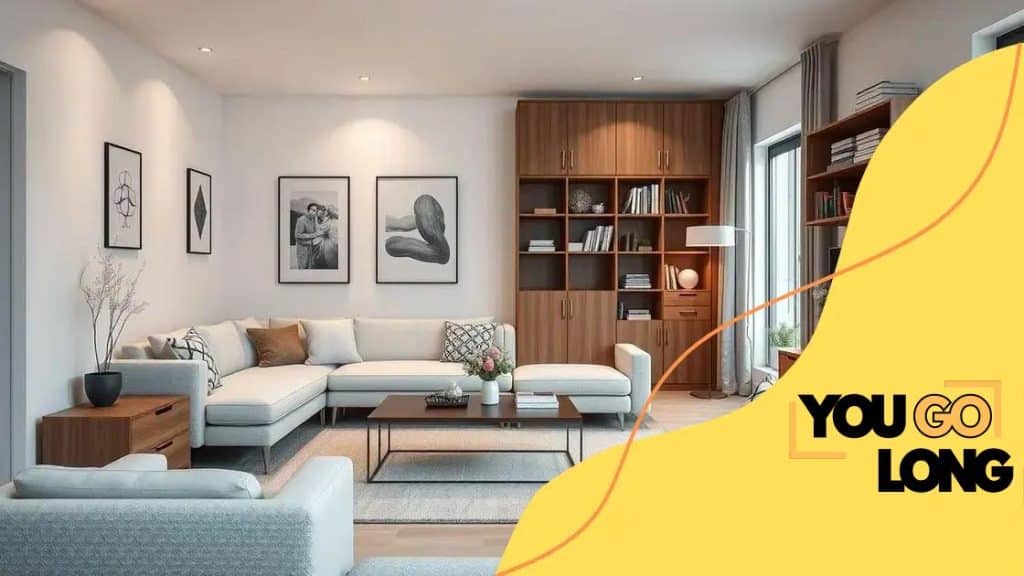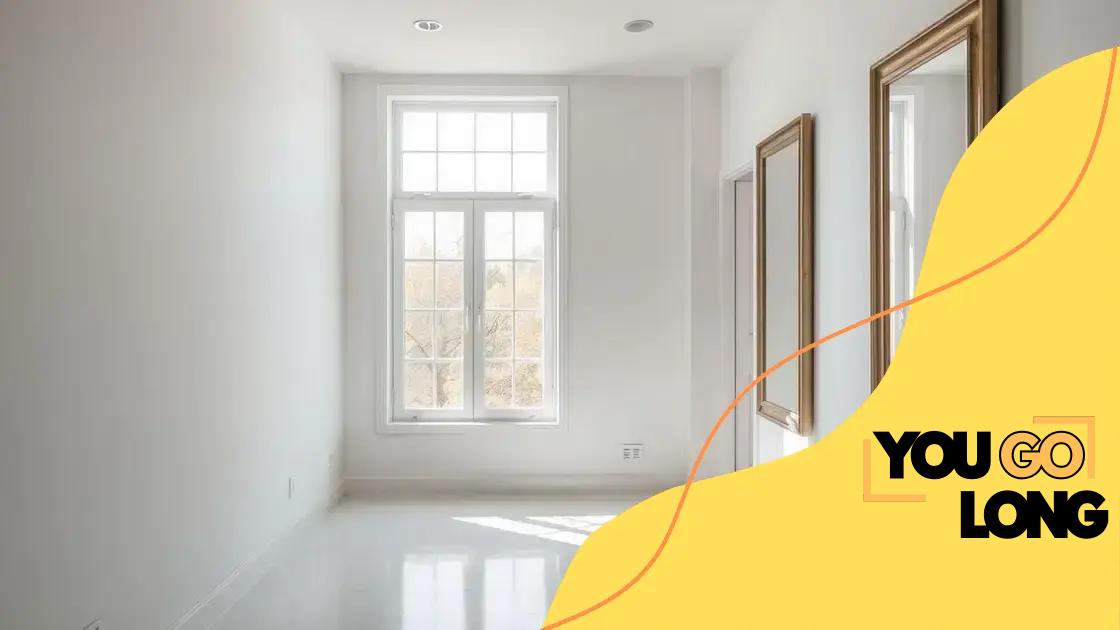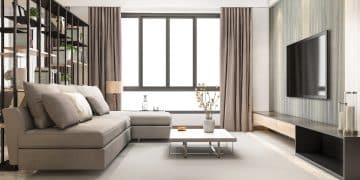How to maximize small space living with home design

Advertisement
To maximize small space living with home design, utilize multi-functional furniture, light colors, smart storage solutions, and personalized decor to create a stylish and functional environment.
Have you ever considered how how to maximize small space living with home design can completely transform your home? Living in a compact environment doesn’t mean you have to compromise on style or functionality. In this article, we’ll explore clever design strategies that not only maximize space but also elevate your daily living experience.
Understanding small space design principles
Understanding the principles of small space design can enhance both functionality and aesthetics in your home. A well-designed small space can feel open and inviting, rather than cramped and cluttered. By focusing on key principles, you can maximize your living area while creating a stylish environment.
Utilizing Vertical Space
One effective approach to small space design is to make the most of vertical areas. When floor space is limited, looking up can provide additional opportunities for storage and style. Using tall bookshelves or wall-mounted shelves helps draw the eye upward, making the room feel taller.
Advertisement
- Install floating shelves to display decorative items.
- Use tall cabinets to store belongings without taking up much floor space.
- Incorporate vertical gardens for a touch of nature.
By incorporating vertical elements, you not only save floor area but also introduce unique design features that enhance the overall look.
Choosing Multi-functional Furniture
When it comes to small spaces, every piece of furniture counts. Choosing multi-functional furniture allows you to maximize utility without sacrificing style. For instance, a sofa that converts to a bed can accommodate guests while serving as your daily seating.
- Consider ottomans with storage capabilities.
- Use coffee tables that can also serve as dining tables.
- Look for desks that can fold away when not in use.
This approach not only saves space but can introduce a playful element to your decor.
Advertisement
Designing a small space also involves using light effectively. Natural light can make any room seem larger and more welcoming. Consider light curtains or strategically placing mirrors to reflect light and open up the space. By doing so, you’ll create an airy feeling that is essential in a compact living area.
Lastly, don’t forget the importance of color. Choosing lighter colors for walls and furniture can considerably brighten up a room, while darker shades can make it feel cozier. To create a harmonious environment, remember to stick with a consistent color palette across different elements of the room.
Choosing the right furniture for small spaces
Choosing the right furniture for small spaces is essential for creating a functional and stylish environment. It’s crucial to consider both aesthetics and practicality. The right pieces can enhance your living area while making it feel open and comfortable.
Consider Scale and Proportion
When selecting furniture, always think about scale and proportion. Oversized furniture can overwhelm a small room. Instead, opt for pieces that fit well within the space. Look for slim profiles that are designed for compact living.
- Choose sofas with a low back and narrow arms.
- Pick tables that can extend or collapse as needed.
- Consider chairs that tuck neatly under tables.
This attention to size will keep your space feeling airy and clutter-free. Select items that complement each other in size and style to maintain harmony in your decor.
Embrace Multi-functional Furniture
For small spaces, multi-functional furniture is a game changer. Look for pieces that serve more than one purpose. For example, a sofa bed can provide seating by day and a sleeping area by night. A coffee table with storage may also be a wise choice.
- A dining table that doubles as a workspace.
- Ottomans that offer hidden storage.
- Beds with drawers underneath for extra linens.
These clever designs save space while adding functionality. By utilizing such furniture, you’ll maximize your space without compromising on style.
Don’t forget about style when choosing your pieces. Light, bright colors can open up a space, while darker hues can create warmth and coziness. Selecting furniture that reflects your personal style also helps make small areas feel inviting. Accessories, like cushions or decorative throws, can add personality without taking up too much room.
Ultimately, it’s about balancing style with utility. Assess your needs and how you use your space regularly. This way, you can choose furniture that enhances both functionality and your home’s visual appeal.
Using color and light to enhance space

Using color and light to enhance space is a vital aspect of small space design. The right color choices and lighting can create an illusion of openness and warmth. Colors can influence the mood of a room and the perception of size.
The Power of Color
To make a small area feel larger, stick to a light color palette. Whites, soft pastels, and pale neutrals reflect light and make rooms feel more open. If you prefer bold colors, use them as accents on accessories or one wall instead of overwhelming the entire space.
- Choose light blues and greens for a calming effect.
- Incorporate soft grays for a modern touch.
- Use bright decor elements for pops of color.
Combining various shades in a single color family can also add depth without making the room feel overwhelmed.
Lighting Techniques
Natural light can significantly affect how a space feels. Allow as much natural light in as possible by using sheer curtains or avoiding heavy drapes. Position mirrors strategically to reflect light and make the room appear bigger.
- Use multiple light sources to create layers.
- Consider pendant lights for ambiance.
- Incorporate floor lamps for additional lighting options.
Layering your lighting creates a sense of depth and can make a compact space feel more welcoming. Soft, warm light bulbs can add a cozy feel, while bright white lights can make a space more energetic.
Additionally, consider the placement of furniture and decor. Avoid blocking windows with large pieces. Instead, arrange furniture to allow light to flow freely throughout the room. Keep furniture away from walls if possible, as this can create deeper shadows and make the space feel smaller.
Ultimately, the thoughtful use of color and light can profoundly transform small spaces, making them function better while looking visually appealing. With some strategic planning, you can create an inviting environment that feels spacious and stylish.
Smart storage solutions for compact living
Smart storage solutions for compact living are essential for maintaining a tidy and organized space. In small areas, effective storage not only helps reduce clutter but also enhances the overall functionality of your home. Utilizing every inch of available space wisely is key to transforming a compact living area.
Utilizing Under-Furniture Space
One great way to maximize storage is by utilizing the space beneath your furniture. For instance, you can find storage bins that slide easily under your bed or sofa. This hidden space allows you to store seasonal items or less frequently used belongings out of sight.
- Consider bed frames with built-in drawers.
- Use baskets or containers under the coffee table.
- Incorporate furniture that can be lifted for additional storage.
By taking advantage of these areas, you can keep essential items close at hand while keeping your living space uncluttered.
Vertical Storage Solutions
Vertical storage solutions are vital in compact living. Shelves that reach the ceiling provide ample space for books, plants, or decorative items. Wall-mounted shelves can also serve as both storage and display areas. Installing hooks or pegboards can further optimize vertical space while adding a unique touch to your decor.
- Install floating shelves to display art or collectibles.
- Use over-the-door organizers for shoes or accessories.
- Employ wall-mounted racks for tools or kitchen utensils.
Vertical storage not only makes use of wall space but also draws the eye upward, creating an illusion of height that can make the room feel larger.
Consider multifunctional furniture, such as ottomans with hidden storage or coffee tables that open up to reveal compartments. This combination of style and utility enhances your decor while providing practicality.
In addition, don’t overlook the importance of decluttering regularly. By assessing your belongings and removing items you no longer need, you can free up space for better storage solutions that suit your current lifestyle.
Personalizing your small space with decor
Personalizing your small space with decor transforms it into a home that reflects your style and personality. While small areas can seem challenging, thoughtful decor choices can create a warm and inviting atmosphere.
Choosing the Right Accessories
Accessories are key to adding charm without overcrowding. Opt for pieces that express your unique tastes, such as colorful throw pillows, wall art, or decorative vases. These items can provide personality and warmth to your space without taking up much room.
- Select bold artwork that draws the eye.
- Incorporate plants to bring life into your home.
- Use mirrors to enhance space and reflect light.
When decorating, try to mix textures to create visual interest. Soft fabrics paired with sleek metals can bring balance to your decor.
Creating a Cohesive Color Scheme
A cohesive color scheme is essential for small spaces. Sticking to a limited palette can unify your decor, making the area feel larger and more organized. You might choose a few complementary colors for your accessories and furniture, helping create a harmonious look.
- Use varying shades of the same color for depth.
- Add a pop of color with smaller decor items.
- Keep large pieces in neutral tones to maintain openness.
Using the same colors on walls and decor can create continuity, making transitions between spaces seamless.
It’s also helpful to keep the decor functional. A stylish ladder shelf can display your favorite books while doubling as a beautiful accent piece. When every item serves a purpose, your space will feel both organized and personal.
Personal touches, like framed photos or handmade crafts, can make your small space feel like home. Integrating memories into your decor can bring warmth and familiarity, connecting you to your space on a deeper level.
In conclusion, maximizing small space living with home design is all about smart choices. By understanding the principles of design, selecting the right furniture, utilizing color and light, and incorporating smart storage solutions, you can create a home that feels spacious and inviting. Personalizing your space with decor adds character and warmth. Embrace these strategies to transform your compact living area into a comfortable and stylish haven.
FAQ – Questions about maximizing small space living with home design
What are the best colors to use in a small space?
Light colors like whites, pastels, and soft neutrals make a room feel larger and more open.
How can I make my small space feel more organized?
Utilizing smart storage solutions, like under-furniture storage, and choosing multi-functional furniture can greatly improve organization.
Why is lighting important in small space design?
Good lighting enhances the feeling of space; using both natural and layered lighting can create an airy and inviting atmosphere.
How can I personalize my small space without clutter?
Incorporate a few key decor items that reflect your style, such as artwork and plants, while keeping other spaces clutter-free.





